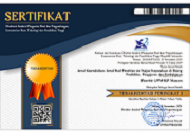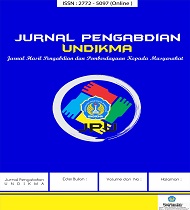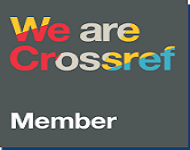Evaluating the Regional Contracted Teachers Appointment Program at the Junior High School Level in Tambrauw Regency, Southwest Papua Province : Context of Education in Remote Areas
DOI:
https://doi.org/10.33394/jk.v10i2.10975Keywords:
Contract Teachers, CIPP, Program Evaluation.Abstract
References
Arikunto, S. (2012). Dasar-Dasar Evaluasi Pendidikan, Ed.2. Jakarta: Bumi Aksara.
Arikunto, S., & Sarifrudin, C. (2014). Evaluasi Program Pendidikan. Jakarta: Bumi Aksara.
Aziz, S., Mahmood, M., & Rehman, Z. (2018). Implementation of CIPP Model for Quality Evaluation at School Level: A Case Study. Journal of Education and Educational Development, 5(1), 189. https://doi.org/10.22555/joeed.v5i1.1553.
Banjar, A., Xu, X., Iqbal, M. Z., & Campbell, A. (2023). A systematic review of the experimental studies on the effectiveness of mixed reality in higher education between 2017 and 2021. Computers & Education: X Reality, 3(August), 100034. https://doi.org/10.1016/j.cexr.2023.100034.
Choppin, J., Roth McDuffie, A., Drake, C., & Davis, J. (2018). Curriculum ergonomics: Conceptualizing the interactions between curriculum design and use. International Journal of Educational Research, 92(March), 75–85. https://doi.org/10.1016/j.ijer.2018.09.015.
E. Mulyasa. (2011). Menjadi Guru Profesional Menciptakan Pembelajaran Kreatif dan Menyenangkan. Bandung: PT Remaja Rosdakarya.
Hakan, & Seval. (2011). CIPP evaluation model scale: development, reliability and validity. Procedia Soc Behav Sci.
lAKIP Dinas Pendidikan Pemuda dan Olahraga Kabupaten Tambrauw tahun 2022. (n.d.).
Irene, E. A. (2023). Evaluation of Teacher Education Curricula and its relevance to licensure examination using Context, Input, Process and Product (CIPP) model. Social Sciences and Humanities Open, 8(1), 100607. https://doi.org/10.1016/j.ssaho.2023.100607.
Leigh, Andrew, & Mead, S. (2005). Lifting Teacher Performance: Policy Report 2005. Australia: Progressive Policy Institute.
Manajemen Dapodik Dinas Pendidikan Pemuda dan Olahraga Kabupaten Tambrauw tahun pelajaran 2022-2023. (n.d.)
Muhadjir, N., & Nugroho, B. (2011). Pendidikan Karakter Dalam Perspektif Teori dan Praktek. Yogyakarta: UNY Pres.
Pusdatin Kemendikbud Ristek, 2021 diambil dari https://apkapm.data.kemdikbud.go.id/.
Nurhayati, & Dkk. (2022). Manajemen Pembiayaan Pendidikan Dalam Peningkatan Mutu Lembaga Pendidikan Islam. JMPIS, 3(2).
Raport Pendidikan Daerah, Kemendikbudristek tahun 2023, diambil dari https://raporpendidikan.kemdikbud.go.id/indikator-akar-masalah/13?jenisNilai=SMP_Umum&statusSatpen=semua.
Shernoff, D. J., Kelly, S., Tonks, S. M., Anderson, B., Cavanagh, R. F., Sinha, S., & Abdi, B. (2016). Student engagement as a function of environmental complexity in high school classrooms. Learning and Instruction, 43, 52–60. https://doi.org/10.1016/j.learninstruc.2015.12.003.
Sugiyono. (2018). Metode Penelitian Manajemen. Bandung: CV. Alfabeta.
Sugiyono. (2020). Metode Penelitian Kualitatif, Kuantitatif dan Kombinasi (Mixed Menthods). Bandung: CV. Alfabeta.
Topo, E. A. (2010). Reformasi Pengelolaan SDM Aparatur, Prasyarat Tata Kelola Birolrasi Yang Baik. Borneo Administrator, 6.
Undang-Undang No. 5 Tahun 2014 tentang, Aparatur Sipil Negara. Diambil dari https://peraturan.bpk.go.id/Details/38580/uu-no-5-tahun-2014
Wijaya. (2018). Profesional Teacher: Menjadi Guru Profesional. Sukabumi: CV Jejak.
Yang, B., Tan, Y., Sarker, M. N. I., Deng, W., Yuan, J., & Firdaus, R. B. R. (2024). A model for evaluating the performance of compulsory education inputs in ethnic areas in China. Heliyon, 10(4), e26247. https://doi.org/10.1016/j.heliyon.2024.e26247.
Yang, X. (2023). Creating learning personas for collaborative learning in higher education: A Q methodology approach. International Journal of Educational Research Open, 4(May), 100250. https://doi.org/10.1016/j.ijedro.2023.100250.
Zhang, G., Zeller, N., Griffith, R., Metcalf, D., Williams, J., Shea, C., & Misulis, K. (2012). Using the Context, Input, Process, and Product Evaluation Model (CIPP) as a Comprehensive Framework to Guide the Planning, Implementation, and Assessment of Service-learning Programs. The Encyclopedia of Applied Linguistics, 15(4), 57–84. https://doi.org/10.1002/9781405198431.wbeal0966.
Downloads
Published
How to Cite
Issue
Section
Citation Check
License
License and Publishing Agreement
In submitting the manuscript to the journal, the authors certify that:
- They are authorized by their co-authors to enter into these arrangements.
- The work described has not been formally published before, except in the form of an abstract or as part of a published lecture, review, thesis, or overlay journal.
- That it is not under consideration for publication elsewhere,
- That its publication has been approved by all the author(s) and by the responsible authorities tacitly or explicitly of the institutes where the work has been carried out.
- They secure the right to reproduce any material that has already been published or copyrighted elsewhere.
- They agree to the following license and publishing agreement.
Copyright
Authors who publish with JK agree to the following terms:
- Authors retain copyright and grant the journal right of first publication with the work simultaneously licensed under a Creative Commons Attribution License (CC BY-SA 4.0) that allows others to share the work with an acknowledgment of the work's authorship and initial publication in this journal.
- Authors are able to enter into separate, additional contractual arrangements for the non-exclusive distribution of the journal's published version of the work (e.g., post it to an institutional repository or publish it in a book), with an acknowledgment of its initial publication in this journal.
- Authors are permitted and encouraged to post their work online (e.g., in institutional repositories or on their website) prior to and during the submission process, as it can lead to productive exchanges, as well as earlier and greater citation of published work.
Licensing for Data Publication
-
Open Data Commons Attribution License, http://www.opendatacommons.org/licenses/by/1.0/ (default)

This work is licensed under a Creative Commons Attribution-ShareAlike 4.0 International License.







